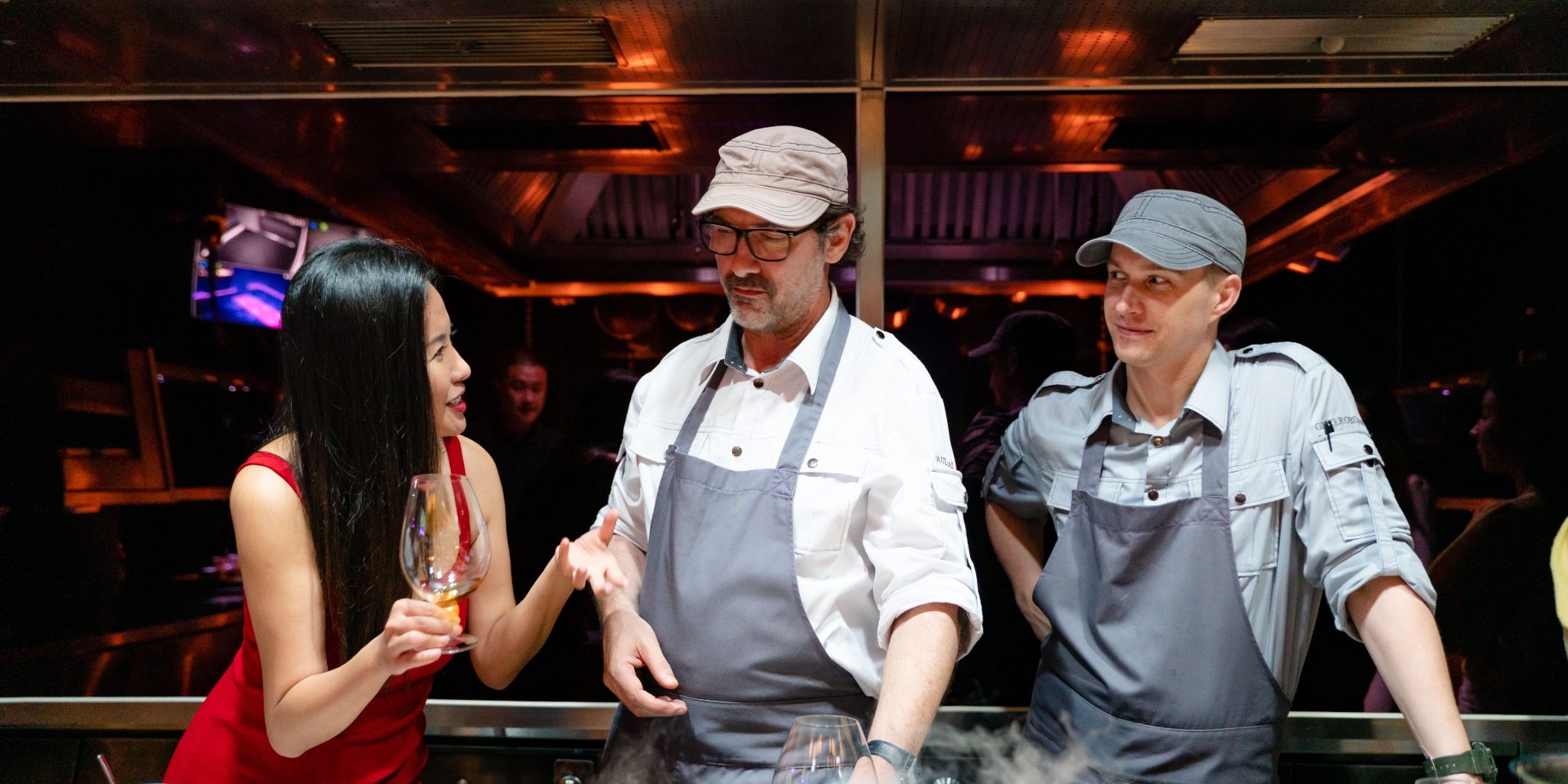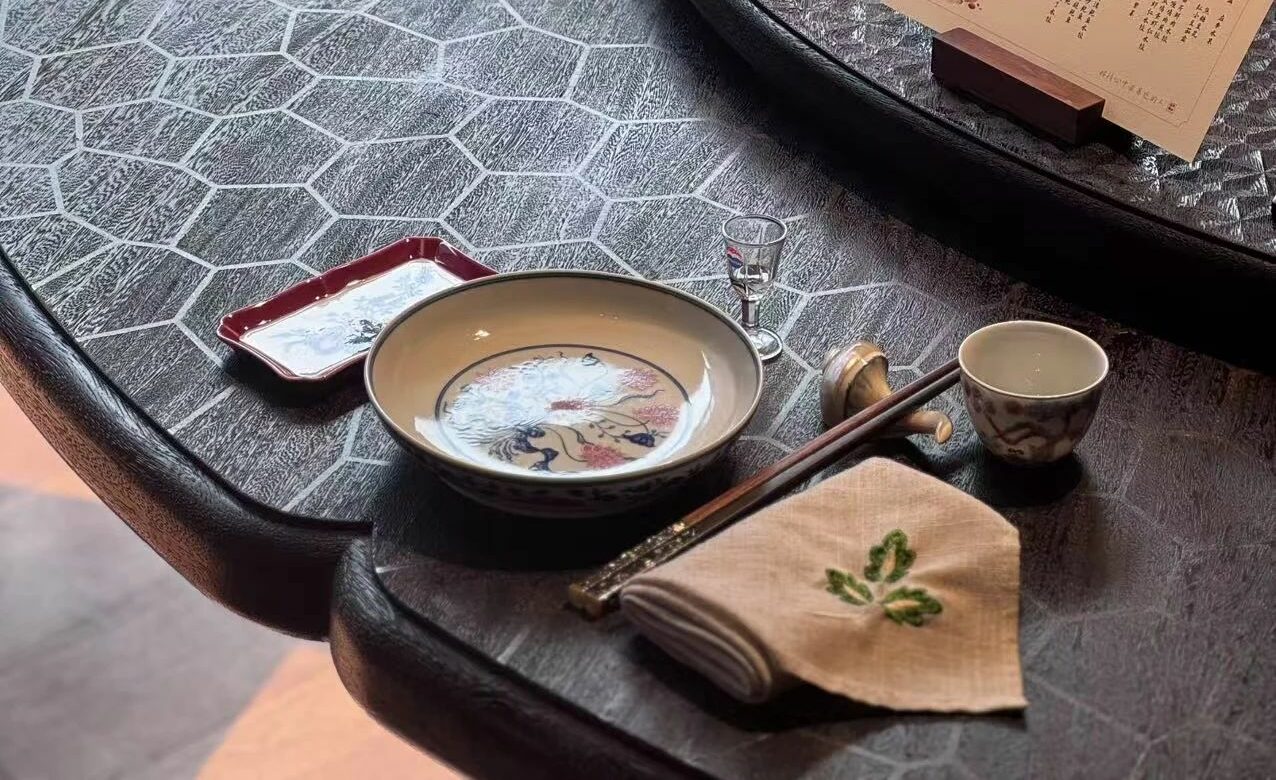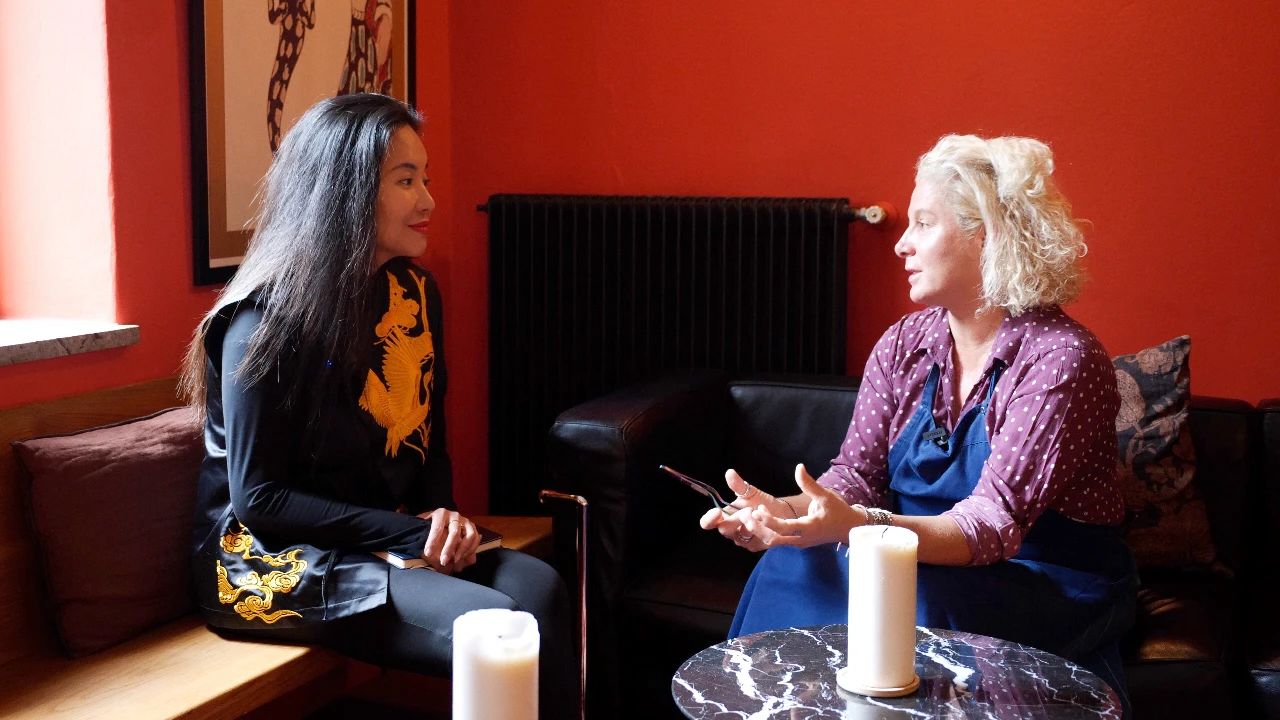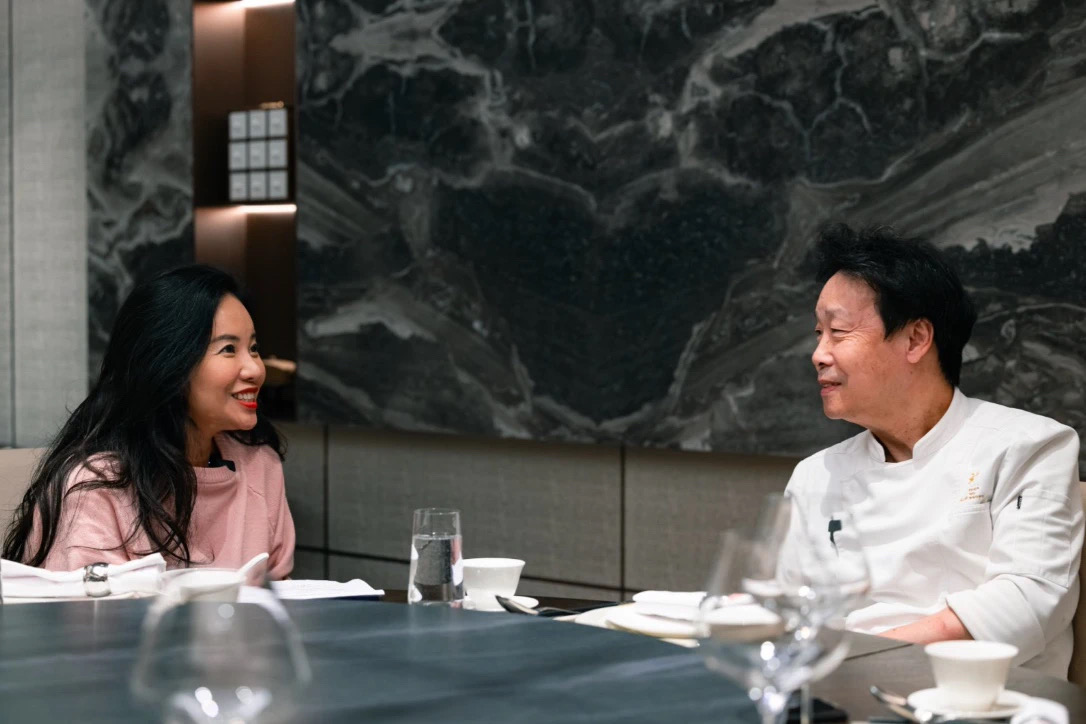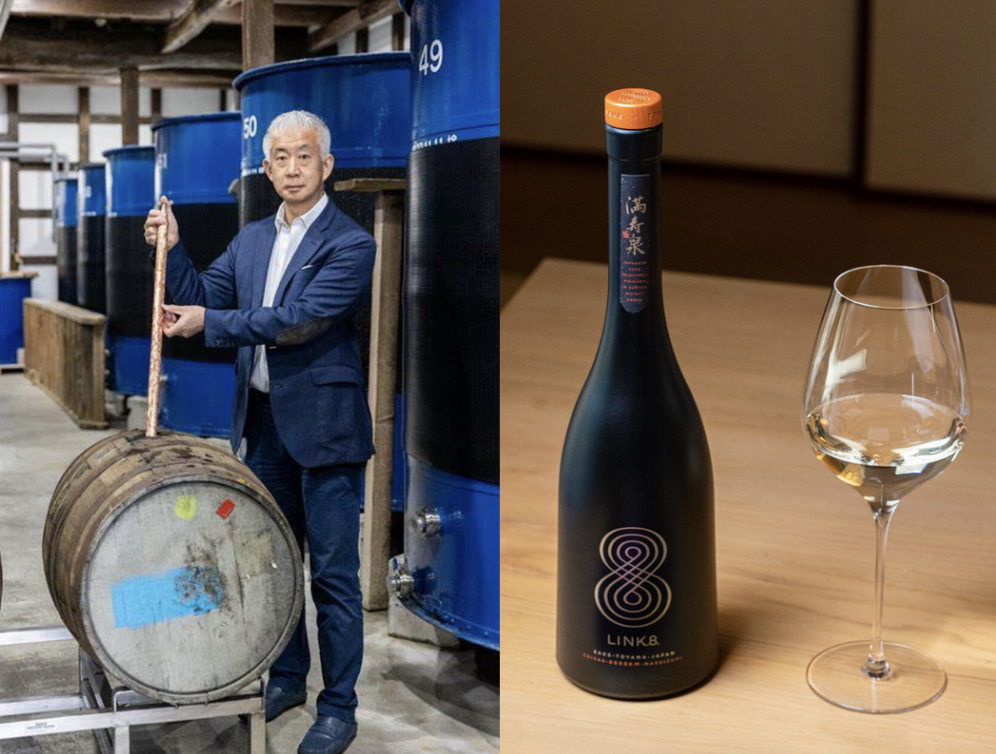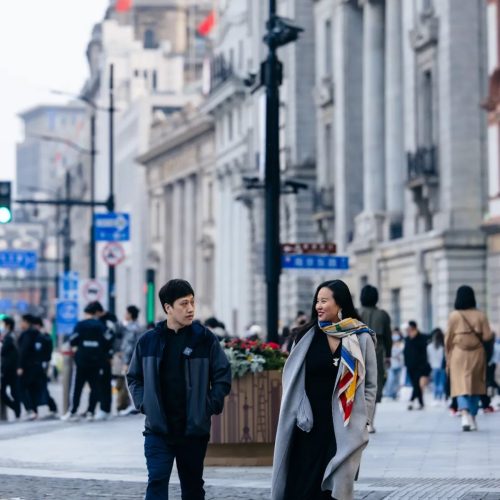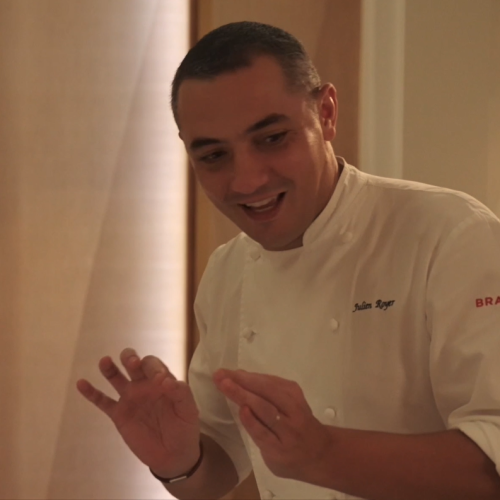“It’s not about technique, it’s about the relevance of the dishes to each other.”
Jocelyn: My first question is: next year UV will celebrate its 10 year anniversary. Can you recall some of the highs and lows over the past decade?
Paul: Yes. The highlight of my career will remain probably the opening of Ultraviolet. There was a Table 0 before the official opening of UV. I invited a table of friends who had helped us to build UV. That has been the most important moment of my career, because it was the realization of a dream that was already there since 1996 and finally I had my own restaurant in 2012, a restaurant just like what I had in vision. It is very complicated, in between what you dream and what you do; there is a big gap sometimes. To be honest there is something very funny. Two weeks before the opening, we still thought we were not there and something was missing. The food was done, scenario done, but there was still something that was not working. In fact, I realized we need to do some test tables though every menu here I already tested about 30 times. It is where we get the balance of the menu, which is very important for UV. We didn’t realize before because it’s a 22-course menu but the courses are set in the fashion that they balance each other which is a most interesting thing in creation. It is very difficult to judge UV, for instance in Michelin fashion, if Michelin continues to judge the dishes one by one. With such criteria, some restaurants may be three Michelin stars and some will not get them. This criterion does not matter. It is not about technique, it is about the relevance of the dishes to each other, about dishes coming together at the right moment. So at that time we rebalanced the dishes and that’s the menu you see now. This is the most difficult and important thing. That’s why it’s so difficult to design a menu. For example, the famous Spanish restaurant El Bulli used to have a small-bites long menu. At the time, balancing the set menu was not on the chef’s mind. It would have been nice if it had been taken into consideration. No one had thought about designing a menu with “climax”. It’s great that this has been achieved.


Jocelyn: The tree was already here when UV came?
Paul: Yes. It was here before this room was finished.
“ The technology and images that many people mistakenly think dominate our senses,
and many people who copy us mistakenly think so. ”
Jocelyn: I was asked if UV had changed the projection.
Paul: Why would they ask? (Maybe people care about the pixels in the picture?) Well, to be honest, did they come here already? (Yes.) Well, there’s a reason for that. Let’s look at some examples, in China we can get LEDs that are brighter than what we’re using now, but a brighter picture takes away the whole feeling that we’ve created. If people do come to UV, what they can get from UV is more of a sensory experience. Do you know why they see those pixels? It’s not from what they eat, but from the photos that they take. That’s why. Why do people come to UV? It’s very rare that people come here and say, “oh it’s too much pixel on my table”.
Jocelyn: For me, it’s a bit of a funny question. But it’s curious to be asked too many times, and I never think about that.
Paul: The problem is that when they leave UV, they look at the photos and see those pixels. Most people see UV dishes from the photos they take, which are not quite the same as you see on the table because of the shade of light that’s covering the dish. But it’s not about the technology. It’s so much more about the feelings that you try to convey through the dishes, rather than the technology and images that many people mistakenly think dominate our senses, and many people who copy us mistakenly think so. It’s more about “relevance”. What do you feel when you see that tree? A touch of nostalgia, a touch of earth, a bit of sadness, that’s what you should think about. It’s not like I’m going to put a picture of a temple or put some really sad music to it. What I’m going to do is evoke memories, so everything that’s done is for that purpose: the music, the smell, the images, it’s all relevant. It’s fun.
I’ve noticed some trends nowadays. We went on 4k images. We watch TV, some old movies, and 4k deepens reality. But it kills the movie; you see it as if it were a reflection of reality. Especially for older films, the charm of them is gone when they are on high resolution. The charm only exits on the cinema screen. High resolution kills the movie.
Jocelyn: Digitization isn’t always good.
Paul: For UV, take the LED for example. The light is very soft now. The projector cost us a million USD when we bought it and the visibility of the whole room was probably less than one metre, and that’s why we chose it. Ten years later now these devices are definitely much cheaper than they were then. The projectors are much brighter now and we can try to find some options with the new technology that has much nicer colours. I would say that most of the images at UV are still images on a simply loop. I have repeatedly said that we don’t want to put an extra artistic layer on the wall, and we don’t want it to “compete” with our dishes. We are just here to complete the dishes. So it’s not the setting that matters, it’s the dish. We have 13 minutes for each dish, and whatever you do, you’ll be there during that time, seeing the dish and listening to the music. It’s kind of an extrapolation of what the chef is trying to communicate to you with these decorations, with the broken wood. There are times when it communicates perfectly, and there are times when what you think is not the chef’s intention. Everybody has an intention, and even McDonald’s has an intention and it thinks about what to put on your plate. We have two such intentions: one is to deepen the memory of the dish for the diners. We have created a “fake”, “non-real” dining environment, which it is only connected to the dish and nothing else. When you go to other restaurants, nothing is relevant to the dish. Even the world-famous Plaza Athenée, rest in peace, my favourite restaurant in the world!


Jocelyn: What a joke…… (Michelin three stars restaurant Plaza Athenée in Paris ends a 21-year partnership with Alain Ducasse)
Paul: Beautiful décor, beautiful, clever tools, the most fantastic service in the world, one of the best team in the kitchen. Removing Alain Ducasse from this place is about the crime as if removing him from Paris. Anyways, Plaza Athenée’s beautiful décor means that diners can have a great experience in the restaurant. As a restaurant, the only aim of UV is to contextualize the dish. What I also like about PA is that it is risky; it’s not like other Michelin three-star restaurants. PA is very conceptual.
Back to Table 0. There will never be that tension again. After two months of preparation, the kitchen was ready to go that night, and you can’t imagine the state of readiness. There were zero service errors that night, which has never happened before in a kitchen’s opening. Because we were so well trained. I was shivering all night. Unbelievable. The feeling of finishing the first table, and the whole team, maybe for the first time, everyone was on the same level of tension. Tension is great, if it’s positive tension, and everyone was super focused on doing their best. It was the most difficult pace for UV. We put a lot of effort into controlling it, down to the second. Everything else is dishes. But we don’t have to worry about the dishes because we’ve been preparing it for a long time. At UV we have a lot of freedom, we put the strain on diners because we control what they eat and we control the time. But we also have the pressure of the tempo, especially with a 20+ course menu. People need to make time for dinner. There are breaks in the middle, a three-minute opening after one bite, followed by 30 seconds for diners to get a feel for the environment, before another bite, removed after one minute, and so on and so forth. The most important thing for UV now is the balance of the tempo and the menu. I’ve never talked about this.
People talk about creativity of UV. Someone says that creation is a matter of space and time, creating a specific period of time. I’ve done a lot of creative dishes and a lot of creative times, and Table 0 was very high of the restaurant. Each new menu since then has also been a joy for me, and certainly for UV.
Getting three Michelin stars is the dream of all chefs. It is very complicated to judge, and getting the stars was a very strong moment. It could personally hurt me if I lose a star one day, but it’s not something I can control. A lot still depends on the judges, because it’s subjective in the way that you like a dish more or less.
The dishes in the UVD will be the only ones of their kind. In the new menu, this “newness” is reflected in the concept, the technique, and the overall flavour combination. I know there are other chefs who think so too. But I want to link the dishes on my new menu to popular taste sensation that has not yet been realised. That’s what I like best. I can guarantee that when the menu is finished, there will be something “new”. And by new, I mean something non-existing on the market today that people have never seen before. For example, one of the dishes is Chaud-Froid Chaud (literally hot-cold-hot in French). It’s a cold dish in 1950s’. We tried to replicate this dish but making the perfect jelly was something very interesting to explore. One idea. You don’t want to sacrifice two ideas because two ideas are too expensive to realize. I need to make sure that the ideas on the new menu is unheard of and I let people know about it.
The most important thing is the menu itself. Table 0 is the best moment of UV and it is above everything else. Maybe I’m the only chef to say this, but UV is so peculiar and so personal, its opening supersedes everything I’ve done in my career, including getting three Michelin stars. I’ve done it. Yes, the opening of UV was the strongest scene ever.
And the toughest part of all was the construction of the UV. It went through three rounds of major renovations. Let me give you a simple example of how we started this project with construction. The space was originally a recording studio. For some reason, the construction team tore down the original roof, because of a misunderstanding. It cost a lot of money to recreate that roof. That’s how the construction started. This is just one of many examples. The truth is that everyone is assuming that UV is a small project, and it’s going to be an easy project in terms of construction. But because it was a new restaurant, we hired 20 teams, and none of them agree with each other. They couldn’t reach a consensus. So this was probably the most complex restaurant project to do at the time. We did it. It was so much more complicated than Mr & Mrs Bund (MMB). The technology, the space, but overall it’s just the hall and the kitchen. UV is ten times smaller than MMB, but 1000 square metres for 10 diners, which is huge and ten times more complex than MMB. This explains why there was one-and-a-half-year delay.
“ Keeps it simple, not ‘simple’,
but evokes images that people have forgotten.”
Jocelyn: Let’s talk about your plans for the next decade for UV. To be a bit straightforward, how long do you want to keep running UV? Have you thought about closing……?
Paul: I don’t think about that. I’d probably say how many years it takes to feed UV by doing other projects. If UV is the only project I could do till the end of time and yes I would be very happy to do this. But we need to think about the financial and commercial growth of the restaurant, which is also important.
Now …… we could update the technology, not only the technology, but the ideas need to be reviewed as well. What is more important is how to get my ideas across to the audience like an opera. That’s the only problem for UV. If someone is willing to invest more money for me to do better technology, that’s great. What we want to do now is to find a solution that keeps it simple, not “simple”, but evokes images that people have forgotten. Everything we see now is for this purpose. The good technology is not about having a 3D animated figure spinning and jumping around the table. If it’s relevant to the dish, it’s perfect. There is some great 3D technology on the market now, and if it complements and relates to the dish, I would use it. It may require financial investment and support, but we can write proposals, for example, we had some investors from Macau. We can find some technical solutions to make this project flawless and write proposals, because these technologies need a lot of financial support.
At the end of the day when we want to do UV project elsewhere, I don’t think we’ll reproduce UV, we will transfer UV. Maybe one day UV will disappear from Shanghai and we’ll go somewhere else. We’ll be at a new place and people will ask if there will be a new menu. I’d say, “Man, I spent two years developing and finalising the menu. You think I’m going to redo a new menu overnight? Of course, it’s not something out of the question, there’s no plan on this. All in all, if we’re not in Shanghai anymore, we’ll transfer UV to somewhere else.
Jocelyn: Do you get angry at being copied? In Ibiza there is a restaurant, Sublimotion.
Paul: It is true that it is a copy of UV. But my answer to your question is “No”. It’s a free market. If someone wants to do better, why not? You can use this technique with any dish, but at least the dish has to be good, otherwise why make it a show. The chef has to be creative and have ideas for his dishes.
Sometimes copying can be done very well. There is a restaurant in Germany, I will save the name, but Germany has the highest level, fueled by imagination of others, of execution in terms of copying other people’s dishes. One of them, they learnt three dishes from us, three dishes!
Jocelyn: How did they get the recipe?
Paul: I know there are some chef fans of UV who come to our restaurant. Once, three Michelin one-starred chefs came here. Some of the chef fans are famous. A German chef, a French chef, very famous on TV. Very, very famous, and he published one of my dishes. I looked at it and thought, “How could you ever consider publishing one of my dishes? And it was published by a professional publisher in France.
There have been a few cases like this. Some cases I don’t mind, but there were some cases I was extremely upset. One day, I saw a French article on Atabula mentioning that I wasn’t the first person to have made my lemon tart, but that another guy had made it before me. (Atabula is a French media outlet that focuses on the restaurant industry and they track the latest developments in the French and European restaurant scene.) He must be joking. I made this lemon tart in 1998 in Paris, when it wasn’t so famous because I had been at Café Mosaïc for two years. The lemon tart became famous in Istanbul, Turkey, in 2001.

lemon tart
They must have forgotten to mention to the press that this is actually my dish. I was very upset that day when I saw the article on Atabula. So I then shown them the menu, the photo, the press article etc. and finally Atabula clarified. The lemon tart took inspiration from traditional French candied fruit. This lemon tart, which is hardly available outside my restaurant, uses whole candied lemon and is served with lemon sorbet. And it’s a lot of work. It’s incredible.
Jocelyn: Have you released any video about the process how to make the lemon tart? (The dish is available at MMB.)
Paul: No. But there was a video made by a Chinese blogger. She tried very hard to replicate it. She probably got the recipe from that published German chef’s book. But it’s hard to find that article. The whole process of making the lemon tart is very elaborate. I guess they probably had to use up 2000 lemons to have three finished products.
“What matters is that the menu at UVD will be completely new.”
Jocelyn: We talked about UVD a bit earlier, will you give us more details now?
Paul: Sure, what would you like to know?
Jocelyn: When will we officially see UVD on the table?
Paul: No one knows. Although the menu is for UV’s 10th birthday. To finish the menu, we have always need to do a little bit more than what we need and that’s a killer sometimes, because we need to cancel some of dishes that I love. That’s the difficult part. But the already finished part is actually quite long and I will not be there for the remaining part. I will leave it to others in the kitchen to finalize. The menu D is 90% complete. I have always wanted to do this over the last four years but every time I was interrupted.
I’ll be back to France at the end of this month and we’re reviewing the final details. I can’t say it’s completely finished, and I can’t do it all. We’re thinking about every detail, about whether to drop certain parts until I can leave the kitchen and the rest of the kitchen knows how to make the dishes. Then I’ll sit down and try the whole menu at least 20 times, usually nearly 30 times. This way I can balance the quantities and the intensity of the dishes. The intensity is how much salt, vinegar, to put on the dish and where to place them to make sure they are powerful enough but also in line with everything else. In the process, cancellations can happen. We now have 30 dishes that we expect to put on the menu.
Jocelyn: 30 dishes?!
Paul: At the beginning there were 100 dishes. 100 ideas. Some of them are already here, probably 10 or 20 that are from the previous test. We select them because we think it would be interesting to finish them. For me, it doesn’t matter whether it’s an idea from the past or not. What matters is that the menu at UVD will be completely new. Sometimes I need an old dish to balance the menu. So it doesn’t matter if the dish was made in 2001 or 1998. In UVC, for example, all the dishes are new, except for the Mango Master Guest, which dates from 1989, when I first became a chef in the restaurant. It’s not exactly the same shape, but the composition is exactly the same. Because we asked the people in the room to do so we wanted something a bit forgiving and not too difficult to do. So we selected this one. Apart from this dish, everything else is new.



We see this as a very interesting part, the finishing of UV. There are a few dishes that need to be confirmed and we will start to play on the scenario. Sometimes I’m very directive, but this time not so much. Because the team this time has worked with me on menu C before, I will let them run more, always based on the idea of the dish. There are 2 or 3 directions. In general, I will do mood board, which I haven’t done yet and I’ll probably do it from Paris and start to install the music that I want. From there we have about six months to finish the scenario, which is not too much time because it’s complicated. And with about two months left, we calculate the time needed for each detail, down to the second: the synchronization of everything we do, the sequence of service. We don’t know yet the way we will be serving the dishes, what would be the plating, or what would be the format.
Jocelyn: These are the timing and calculation for the service. So one more question, did you decide all the music by yourself? (Personally, I love all the music at UV.)
Paul: Not all of them. I give some directions for the team, because otherwise it will not go anywhere. They would ask me which image I want and I would choose. I didn’t decide the final music, Kim did. We all have the right to decide. The way we work is that we create a new “truffle bread” folder, for example, and I put two pieces of music in that folder that fit first. This is the style direction I want to take and others are free to propose something else, and if I think it’s better I would take them. But in the end, the final decision will be based on the direction of the dish. I want something that is relevant to the dish, that’s what I call “directive”. With regard to the background, sometimes we want something fun, maybe a sketch from our own creation, but sometimes a simple image that you can buy is enough to convey what the dish is about. There should not be a competition between the artistic layer on the wall and the food. What is important is to find a balance. I think we did quite well with the first three menus. I hope we will find it for the last one.
Jocelyn: I have a playlist of all of UV’s menu music saved on my phone. My understanding is that UVD is almost 100% new?
Paul: There are already 30 new dishes, and I would need to cancel some. I may have one or two courses from the old menus.
Jocelyn: Ok. So still it’s a new menu like UVC. (UVA and UVB are mainly old dishes that Paul has done before, but UVC is all new dishes.)
Paul: What I mean by “new” is never seen, never tried, never tested by anyone except myself. Now we start to spread the execution and improve the technique. The challenge is not to create, but to produce, so that the team can produce better. We have assigned a few staff members in the kitchen team to be in charge of a few dishes.
Jocelyn: People ask me about the difference between the three menus A, B and C. What is your answer to it?
Paul: The only difference is that the dish is presented differently on the table. It is what it is. Some people would say that menu A is more playful, B is more technical and C is more …… I don’t know how people would describe it. It’s a personal feeling. For me, I have the same emotions for each one. They are like my babies, and it’s hard for me to judge them. One of the things I find difficult to do is to get all three menus to the same level. If the first menu is the best, then the second has to be at least that good, and that’s the difficult part. I don’t work on themes. I don’t say we are going to have a specific theme this year. I don’t even work on memory. Sometimes I discover later myself, that I hardly do some theme which is not in connection with my memory. It’s very rare but it is the case with a lot of chefs. It’s not intentional.
There’s another one that is not completely lost. You know the Laughing Cow? It’s a commercial cheese that’s sold in the box like this, with the cow. It is very famous and I had this since I’m a kid. Now it’s a problem, because as a chef, it is difficult for me to go in the supermarket and buy something like this in a basket, right? People would say you don’t buy fresh product. There are several that I’ve loved since I was a kid and they’re all really good products. Like Nutella, you know? I put them together and it’s a hard thing to make them interesting. I sometimes convince my French friends. It’s very difficult to get down to specifics. But it’s a memory for me and this year also happens to be The Laughing Cow’s 100 years, so I can’t delete the dish now. C’est la vie. Maybe afterwards!
Jocelyn: Now it takes four months to make a reservation. It’s even more difficult than before.
Paul: No. Not true. On the contrary, in the past we open the reservation for three months, but now we decide to open for four months. So actually you have more opportunity to make a booking. If the booking period is opened up to six months or a year, people might fail to book. The problem we have is that UV is one of the first restaurants to ask for a prepayment to secure a seat. If you ask too much ahead, many people cannot be sure of their schedule. So we decided to go 3 or 4 months in advance. We didn’t want to cause too many problems with the booking bit. Due to the high demand, we are now slightly ahead to 4 months. If someone cancelled a booking, someone else will soon fill it.
With the pandemic, we mainly have domestic diners now. So the reviews I see now are not as good as I think they used to be, maybe because people don’t resonate as strongly with the scene and the dishes. I’ll make some adjustments, but at the end of the day I’m still French. A lot of the scenes are from my home. If you listen to my telephone music, you would be disappointed because it’s mainly some old crap from the French 70s.
“Our ambition is to make something easily identifiable,
something that is existing on the market,
something that is simple but tastes right.”
Jocelyn: Are you planning on any new projects in Shanghai?
Paul: Probably will try this year. I can’t tell you right now, because it’s not completely signed yet. VOL is my partner and we have already done MMB, UV, Polux and they want to do something again this year. I will be involved as well. A simple and fun commercial project where you can dine all day. I don’t have the time to do an ambitious fine dining project.
I will use my resources for this project. I want to introduce the notion of “All Day Dining” to Shanghai. I could have done a small Polux because there are some here seem successful. It will take some feature from a café from Polux, but also adding elements of a bakery and sandwiches, which I would like to add. This project is still under discussion. I need to know some directions, floor plans, what the kitchen will look like, etc. I need to trust the team now and I will give some direction and a plan. When I get back to Shanghai, we will try to start right away.

Photo by Scott Wright of Limelight Studio
Jocelyn: As you’re leaving for Paris, do you have any new restaurants opening there?
Paul: No problem. September 2022! We would like to open when I am there. I’m sure this will be a perfect project. We have delayed the opening, which was originally planned for December this year. Meanwhile the whole team is what I wanted and the whole process took longer than we expected. In the end we settled on September 2022, a year from now.
All situations have been made complicated in terms of investment by the Covid. Many hotels and restaurants in France have been closed for months due to the pandemic. A high-end hotel will lose millions of euros if it is closed for a month. There has been some help from the government for the business, but the whole situation is still very uncertain. Don’t forget, we are not even out of it. Some places haven’t reopened yet.
It’s a bit relaxing now but whenever we want to relax, there’s been another wave. Last time I was in Paris, I cannot go to restaurants. All the restaurants were closed. That’s incredible. That’s impossible.
Jocelyn: I couldn’t imagine there is no restaurant to go in Paris. What would your new restaurant in Paris be like, more causal or fine dining?
Paul: A casual brasserie. It would be more like MMB and Polux. Maybe not an ambitious piece. The point is not to be over ambitious. I’ve talked about almost all my projects today, and to do a fine dining project in France would require my presence for at least half of the year. The goal is not to shock the world or showcase my highest level, but to make something simple and delicious. It’s also what I’m doing in Polux, which is not a common type of restaurant even in France. It’s rare to see this kind of beautifully simple restaurant because people always overlook something that looks simple and daily scene. You can do a Polux with two chefs in the kitchen and a total of 16 staff. Our ambition is to make something easily identifiable, something that is existing on the market, something that is simple but tastes right. It would actually be a difficult thing to do if you apply this to the dishes on the menu. Many people could do it, but do they have the will? There are very few restaurants like this in France. The competition is high and the new generation of chefs are not sure if simplicity is good enough. It’s hard to find a restaurant that simply makes a good meat, a good dish.
Jocelyn: For me, I find the food at Polux and MMB very tasty and consistent. You know, I can’t eat anything bad.
Paul: The quality of a place is regardless where you do. Some people say that Polux is a very good boulangerie for Shanghai. We say, no, if you put it in France and it’s also a very good boulangerie, one of the best. That’s where the project gets its value from. It can’t just be good in Shanghai, it should be good universally.
– End –
Editor’s Thought by Jocelyn Chen:
Interview/Edit:Jocelyn Chen
Edit:Celine Chen



